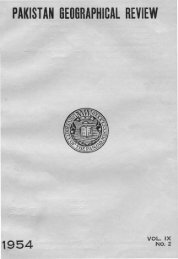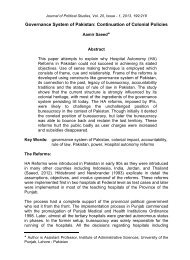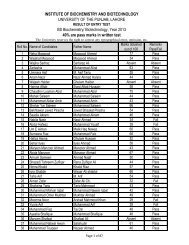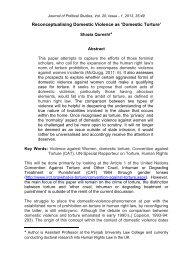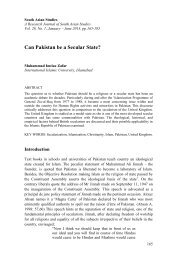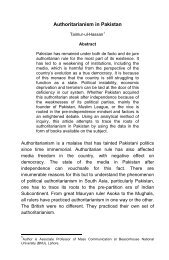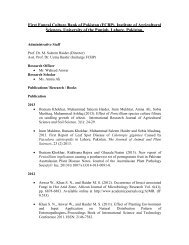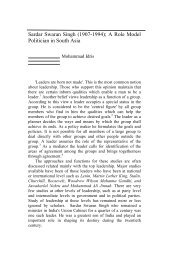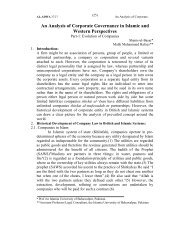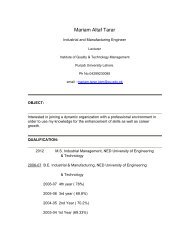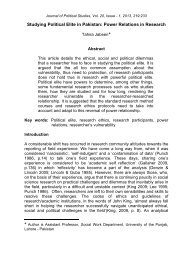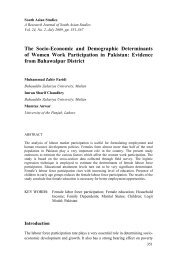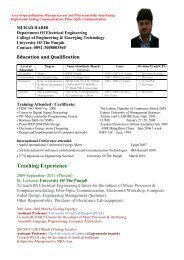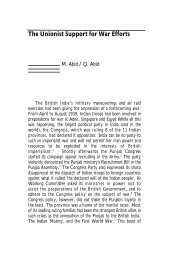The Significance of the Different Names Applied by Historians to the ...
The Significance of the Different Names Applied by Historians to the ...
The Significance of the Different Names Applied by Historians to the ...
Create successful ePaper yourself
Turn your PDF publications into a flip-book with our unique Google optimized e-Paper software.
Journal <strong>of</strong> Political Studies, Vol. 19, Issue - 2, 2012, 179:197<br />
<strong>The</strong> significance <strong>of</strong> <strong>the</strong> different names applied <strong>by</strong> his<strong>to</strong>rians <strong>to</strong> <strong>the</strong><br />
events <strong>of</strong> 1857<br />
Syed Hussain Shaheed Soherwordi ♣<br />
Introduction<br />
Abstract<br />
<strong>The</strong> nature <strong>of</strong> <strong>the</strong> uprising <strong>of</strong> 1857 has aroused from <strong>the</strong> very<br />
beginning, serious controversy. <strong>The</strong> <strong>of</strong>ficial British explanation<br />
was that <strong>the</strong> Bengal Native Army had alone mutinied, and any<br />
civil disturbances that occurred after, were natural <strong>by</strong>-products<br />
<strong>of</strong> <strong>the</strong> collapse <strong>of</strong> law and order. A British <strong>of</strong>ficial, William Muir<br />
argued that, ‘<strong>the</strong> character <strong>of</strong> <strong>the</strong> affair is that <strong>of</strong> a military<br />
mutiny-a struggle between <strong>the</strong> Government and its Soldiers, not<br />
between <strong>the</strong> Government and <strong>the</strong> People’. However, this view<br />
has been contested largely <strong>by</strong> writers and his<strong>to</strong>rians who argue<br />
that <strong>the</strong> rebellion <strong>of</strong> 1857 was not solely a military act but<br />
involved individuals from various backgrounds.<br />
Shakespeare once questioned whe<strong>the</strong>r a name changed <strong>the</strong> essence <strong>of</strong> an<br />
object, person, or even an event. Leading academics <strong>of</strong> Indian his<strong>to</strong>ry may<br />
indeed have his answer. 1857, <strong>to</strong> this day, equally perplexes and intrigues<br />
his<strong>to</strong>rians on account <strong>of</strong> <strong>the</strong> different causations and implications <strong>the</strong> events<br />
inspire. In this regard, Rawat says:<br />
<strong>The</strong> memory <strong>of</strong> 1857, dis<strong>to</strong>rted but hallowed with sanctity, perhaps<br />
did more damage <strong>to</strong> <strong>the</strong> cause <strong>of</strong> British rule in India than <strong>the</strong><br />
Revolt itself- whatever might have been its original character<br />
(Rawat, 1998:103).<br />
Rawat’s remark exemplifies <strong>the</strong> political nature <strong>of</strong> <strong>the</strong> events <strong>of</strong> 1857, and<br />
because <strong>of</strong> this <strong>the</strong>re are generally four broad categories <strong>of</strong> terms used <strong>to</strong><br />
describe it <strong>by</strong> observers: mutiny, uprising, war <strong>of</strong> independence, and<br />
revolution. <strong>His<strong>to</strong>rians</strong> subscribing <strong>to</strong> <strong>the</strong>se terms use distinct discourse <strong>to</strong><br />
sculpt <strong>the</strong> events and <strong>the</strong>ir significance <strong>to</strong> whichever title <strong>the</strong>y may uphold. It<br />
is my aim here <strong>to</strong> rationalize <strong>the</strong> arguments regarding <strong>the</strong> use <strong>of</strong> each term<br />
and diagnose which provides <strong>the</strong> most accurate description <strong>of</strong> events. This will<br />
be done <strong>by</strong> having a detailed au<strong>to</strong>psy <strong>of</strong> events that <strong>to</strong>ok place during 1857<br />
social and military commotion.<br />
♣ Author is Associate Pr<strong>of</strong>essor, Department <strong>of</strong> International Relations, University <strong>of</strong><br />
Peshawar, Peshawar - Pakistan.
Syed Hussain Shaheed Soherwordi<br />
<strong>The</strong> uprising began with a mutiny against <strong>the</strong> British <strong>by</strong> <strong>the</strong> East India<br />
Company’s (EIC) army in Bengal, in <strong>the</strong> north <strong>of</strong> India. This led <strong>to</strong> widespread<br />
civil and urban unrest in all parts <strong>of</strong> north India. According <strong>to</strong> Bates, <strong>the</strong> unrest<br />
in <strong>the</strong> urban areas was mostly communal, characterized <strong>by</strong> <strong>the</strong> rioting <strong>of</strong><br />
unemployed Muslim artisans critical <strong>of</strong> <strong>the</strong> successes <strong>of</strong> Hindu moneylenders<br />
who had been prospering under British rule. He argues that <strong>the</strong> Company was<br />
taken <strong>by</strong> surprise due <strong>to</strong> <strong>the</strong> insurrection which meant <strong>the</strong> ultimate collapse <strong>of</strong><br />
British power in <strong>the</strong> sub-continent creating an increase in <strong>the</strong> many dissenting<br />
groups. This trait is for Bates, <strong>the</strong> most unique feature <strong>of</strong> 1857 (Bates,<br />
2007:56-61).<br />
<strong>The</strong> P-53 Enfield Rifle Cartridge Issue<br />
As is self evident, <strong>the</strong> term mutiny implies insubordination and rebellion within<br />
<strong>the</strong> military and in order <strong>to</strong> evaluate this position we must discover if unrest<br />
and dissent were limited <strong>to</strong> issues concerning and <strong>the</strong> actions <strong>of</strong> military<br />
elements. <strong>The</strong> <strong>of</strong>t cited cause <strong>of</strong> <strong>the</strong> 1857 sepoy mutiny is <strong>the</strong> introduction <strong>of</strong><br />
pig and cow fat greased cartridges for <strong>the</strong> new muzzle loaded P-53 Enfield<br />
Rifle <strong>to</strong> <strong>the</strong> blatant disregard for <strong>the</strong> religious practices <strong>of</strong> Hindus and Muslims.<br />
<strong>The</strong> loading action required that opera<strong>to</strong>rs ripped <strong>the</strong> cartridge with teeth,<br />
before insertion. <strong>The</strong> combination <strong>of</strong> both pig and cow fat <strong>of</strong>fended <strong>the</strong><br />
sensibilities <strong>of</strong> both <strong>the</strong> Muslim and Hindu sepoys respectively (cow sacred <strong>to</strong><br />
Hindus, and pig inauspicious for Muslims) and was seen as, ‘part <strong>of</strong> an<br />
attempt <strong>to</strong> forcibly convert <strong>the</strong> sepoys <strong>to</strong> Christianity’ (Bates, 2007:65). <strong>The</strong><br />
Enfield rifle cartridges not only undercut religious and caste-system norms, but<br />
also degraded Indian society and identity. Upon <strong>the</strong>ir refusal <strong>to</strong> load <strong>the</strong> rifles,<br />
<strong>the</strong> soldiers were imprisoned. This resulted in a general sense <strong>of</strong> hostility<br />
amongst <strong>the</strong> mutineers who marched <strong>to</strong>wards Delhi <strong>to</strong> <strong>the</strong> Mughal Emperor,<br />
Bahadur Shah, establishing him as <strong>the</strong> head <strong>of</strong> <strong>the</strong> revolt (Bose and Jalal,<br />
1998: 90). It is important <strong>to</strong> note here that although <strong>the</strong>re were o<strong>the</strong>r causes <strong>of</strong><br />
<strong>the</strong> Uprising, British his<strong>to</strong>riographies tend <strong>to</strong> stress <strong>the</strong> issue <strong>of</strong> <strong>the</strong> cartridges<br />
<strong>to</strong> highlight <strong>the</strong> fanaticism and <strong>the</strong> extent <strong>of</strong> superstition prevalent in <strong>the</strong> subcontinent.<br />
Bates also argues that <strong>the</strong> Uprising was an indication that <strong>the</strong><br />
British had misruled India, but were reluctant <strong>to</strong> admit this, <strong>the</strong>refore referring<br />
<strong>to</strong> it as a ‘mutiny.’ <strong>The</strong> term contains trivial connotations depicting <strong>the</strong> incident<br />
as an act <strong>of</strong> treason <strong>by</strong> a group <strong>of</strong> soldiers. British accounts <strong>of</strong> <strong>the</strong> ‘mutiny’ are<br />
<strong>of</strong>ten accompanied <strong>by</strong> accounts <strong>of</strong> barbarities and horrors, making <strong>the</strong> Indians<br />
seem violent and hence, justifying <strong>the</strong> res<strong>to</strong>ration <strong>of</strong> colonial rule (Bates, 2007:<br />
63-66). However, this display <strong>of</strong> British insensitivity in <strong>the</strong> context <strong>of</strong> <strong>the</strong> Sepoy<br />
Mutiny title was merely <strong>the</strong> spark necessary for action <strong>of</strong> long festering sepoy<br />
discontent. It is due <strong>to</strong> this that Mangal Pandey <strong>of</strong> <strong>the</strong> 34 th Bengal Native<br />
Infantry shot at his commanding <strong>of</strong>ficer, an <strong>of</strong>fence that cost him his life but<br />
would later see his likeness reproduced on postage stamps <strong>by</strong> <strong>the</strong> Indian<br />
National Government.<br />
180
<strong>The</strong> significance <strong>of</strong> <strong>the</strong> different names applied <strong>by</strong> his<strong>to</strong>rians <strong>to</strong> <strong>the</strong> events <strong>of</strong> 1857<br />
<strong>The</strong> cartridge issue sparked <strong>of</strong>f <strong>the</strong> uprising <strong>of</strong> 1857; however this wasn’t <strong>the</strong><br />
first instance <strong>of</strong> its kind. As Bates points out <strong>the</strong> 1806 Madras Mutiny was due<br />
<strong>to</strong> <strong>the</strong> fact that new lea<strong>the</strong>r head gear was found <strong>to</strong> be polluting<br />
(Bates,2007:66) - however this mutiny did not result in widespread uprising,<br />
nor <strong>the</strong> expulsion <strong>of</strong> <strong>the</strong> British from Dehli, “<strong>the</strong> ancient capital and modern<br />
arsenal <strong>of</strong> India” (Brendon, 2008:129). What is <strong>of</strong> note here is <strong>the</strong> fact that <strong>the</strong><br />
first regiments <strong>to</strong> mutiny and later march in<strong>to</strong> Dehli were based in Meerut, over<br />
1000 miles away from <strong>the</strong> 34 th Bengal. In an age devoid <strong>of</strong> expedient<br />
communication technologies it seems incredible that <strong>the</strong> circumstances <strong>of</strong><br />
Pandey’s death would travel so far and cause an uprising <strong>of</strong> such scale <strong>by</strong><br />
mutineers who would have never even previously heard his name. <strong>The</strong>re is<br />
evidence <strong>of</strong> o<strong>the</strong>r widespread rumours at this time; it was predicted that, as<br />
1857 was <strong>the</strong> centenary <strong>of</strong> EIC vic<strong>to</strong>ry at Plasse, that this year would be its<br />
downfall and that this was, ‘a prophecy that was widely circulated in north<br />
India’ (Mukherjee, 1990:92) amongst o<strong>the</strong>r rumours, ‘about flour being<br />
polluted <strong>by</strong> bone-dust; about forcible conversions <strong>to</strong> Christianity and about <strong>the</strong><br />
intentions <strong>of</strong> <strong>the</strong> British <strong>to</strong> disarm <strong>the</strong> sepoys’ (Mukherjee, 1990:95). I can<br />
conceptualize <strong>the</strong> Mandal Pandey rumour as merely a catalyst –even <strong>the</strong> self<br />
import <strong>of</strong> <strong>the</strong> cartridge issue is questionable, as it is apparent that <strong>the</strong><br />
mutineers would later use <strong>the</strong> same cartridges <strong>to</strong> fight <strong>the</strong> British. It was in <strong>the</strong><br />
colonial interest <strong>to</strong> attribute <strong>the</strong> mutiny <strong>to</strong> religious, irrational fanaticism 1 as<br />
this disguised <strong>the</strong> true nature <strong>of</strong> <strong>the</strong> uprising (Bates, 2007:66). However, this<br />
extraordinary transfer <strong>of</strong> information <strong>by</strong> gossip provides our first clue as <strong>to</strong> <strong>the</strong><br />
unrest that was plaguing nor<strong>the</strong>rn India at <strong>the</strong> time.<br />
<strong>The</strong> Enfield rifle is <strong>of</strong>ten used as a strategic device (initially employed <strong>by</strong><br />
William Dalrymple) <strong>to</strong> describe <strong>the</strong> sole cause <strong>of</strong> <strong>the</strong> outburst as ‘religious<br />
sentiments being hurt <strong>by</strong> <strong>the</strong> grease in <strong>the</strong> Enfield bullet’ (Bhattacharya, 2008:<br />
14) that spurred an anti-British reaction. This ra<strong>the</strong>r simplistic account <strong>of</strong> <strong>the</strong><br />
revolt <strong>of</strong> 1857 is commonly used in Sepoy Mutiny rhe<strong>to</strong>ric <strong>to</strong> understate <strong>the</strong><br />
important pretext <strong>of</strong> events leading <strong>to</strong> <strong>the</strong> Enfield rifle debacle. This strategy<br />
allowed <strong>the</strong> British <strong>to</strong> subjugate <strong>the</strong> sepoys as erratic, and unstable.<br />
Reward cuts and Overseas Travel<br />
<strong>The</strong> cartridge issue was not <strong>the</strong> only issue affecting <strong>the</strong> military. An allowance<br />
system that rewarded <strong>the</strong> standing sepoy armies extra pay if <strong>the</strong>y were<br />
stationed beyond <strong>the</strong>ir respective frontiers was removed in 1856 (Bates,<br />
2007:66). This directly affected <strong>the</strong> mutinous troops stationed in <strong>the</strong> newly<br />
annexed state <strong>of</strong> Awadh and casts fur<strong>the</strong>r doubt on <strong>the</strong> singular significance <strong>of</strong><br />
<strong>the</strong> cartridge issue - as Pandey was stationed in Lucknow. In addition <strong>to</strong> this,<br />
<strong>the</strong> 1856 Service Enlistment Act forced sepoys <strong>to</strong> agree <strong>to</strong> travel overseas,<br />
1 All belligerents would become known as irrational Pandeys<br />
181
Syed Hussain Shaheed Soherwordi<br />
something which had been voluntary up until, and this issue that concerned<br />
Hindu sepoys fearful <strong>of</strong> losing purity and caste status <strong>by</strong> coming in<strong>to</strong> contact<br />
with polluting foreigners. Even if <strong>the</strong> significance <strong>of</strong> <strong>the</strong> cartridge issue is<br />
limited, <strong>the</strong>re were genuine grievances with military policy which may well<br />
deserved mutiny. However, in order <strong>to</strong> advocate <strong>the</strong> term mutiny one has <strong>to</strong><br />
prove that <strong>the</strong> events <strong>of</strong> 1857 were isolated only <strong>to</strong> military elements as per<br />
<strong>the</strong> British colonial definition – o<strong>the</strong>rwise <strong>the</strong> mutiny is just a part <strong>of</strong> <strong>the</strong> larger<br />
picture.<br />
<strong>The</strong> British rulers termed <strong>the</strong> uprising as <strong>the</strong> Sepoy Mutiny <strong>of</strong> 1857.<br />
Occupation <strong>of</strong> India had long been spun on <strong>the</strong> grounds <strong>of</strong> a civilizing mission<br />
<strong>to</strong> modernize Indians, and thusly legitimize British rule. As such, when <strong>the</strong><br />
mutiny erupted, <strong>the</strong> British wished <strong>to</strong> describe <strong>the</strong> events in as restricted a<br />
fashion as possible, hoping <strong>to</strong> minimize <strong>the</strong> contribu<strong>to</strong>rs as though <strong>to</strong> show<br />
that <strong>the</strong> majority <strong>of</strong> citizens still welcomed <strong>the</strong>ir presence. <strong>The</strong> title <strong>of</strong> ‘Sepoy<br />
Mutiny <strong>of</strong> 1857’ was born, focusing <strong>the</strong> scope <strong>of</strong> discussion wholly upon <strong>the</strong><br />
sepoys and <strong>the</strong>ir behavior.<br />
Growing Grievances <strong>of</strong> <strong>The</strong> Bengal Army<br />
In examining <strong>the</strong> significance <strong>of</strong> <strong>the</strong> epi<strong>the</strong>t ‘Sepoy Mutiny’ one must first<br />
examine May 10th, 1857 from <strong>the</strong> context <strong>of</strong> <strong>the</strong> instiga<strong>to</strong>rs <strong>of</strong> <strong>the</strong> mutiny; <strong>the</strong><br />
Bengal Army. Logistically <strong>the</strong> Bengal Army was composed <strong>of</strong> volunteer<br />
mercenaries hoping for compensation, pensions, and improved living<br />
standards provided <strong>by</strong> <strong>the</strong> East India Company (EIC). However, growing<br />
grievances were fast outweighing <strong>the</strong> incentives for service in <strong>the</strong> EIC Army.<br />
<strong>The</strong> standard rate <strong>of</strong> pay had stagnated at 7 rupees (14 sterling) monthly<br />
since <strong>the</strong> turn <strong>of</strong> <strong>the</strong> century, whereas grain prices doubled between 1796 and<br />
1852. (David, 2002) Barracks <strong>of</strong>ten flooded and leaked for <strong>the</strong> entirety <strong>of</strong> <strong>the</strong><br />
rainy season, resulting in undue susceptibility <strong>to</strong> disease. British leaders’<br />
inefficiency, lack <strong>of</strong> discipline, and motivation left troops wondering why Indian<br />
soldiers <strong>of</strong> greater intellect and military prowess remained <strong>to</strong> be promoted.<br />
(Dunbar, 1939) Fur<strong>the</strong>rmore British soldiers had security in higher wages, and<br />
generous length <strong>of</strong> service including promotion. Concerns over measly pay<br />
had been quelled since Indian sepoys <strong>of</strong>ten employed plundering and<br />
pillaging <strong>of</strong> conquered terri<strong>to</strong>ries as a wage supplement. But as <strong>the</strong> world<br />
became smaller and conquests <strong>of</strong> India slowed, <strong>the</strong> only terri<strong>to</strong>ry left <strong>to</strong> loot<br />
was abroad. (David, 2002) Hindus objected <strong>to</strong> fighting abroad as a violation <strong>of</strong><br />
<strong>the</strong>ir caste-rules, while Muslims wished <strong>to</strong> remain peaceful with <strong>the</strong>ir religious<br />
brethren in outlying terri<strong>to</strong>ries like Afghanistan. (Beck, 2007) <strong>The</strong>se growing<br />
lists <strong>of</strong> hardships were fast mutating in<strong>to</strong> resentment <strong>of</strong> British<br />
authoritarianism, and <strong>the</strong> bubbling <strong>of</strong> discontent was bound <strong>to</strong> become a boil<br />
when sepoys realized <strong>the</strong> extent <strong>to</strong> which Britain had become entrenched in<br />
all things Indian, including <strong>the</strong>ir land.<br />
182
<strong>The</strong> significance <strong>of</strong> <strong>the</strong> different names applied <strong>by</strong> his<strong>to</strong>rians <strong>to</strong> <strong>the</strong> events <strong>of</strong> 1857<br />
It is important <strong>to</strong> note whe<strong>the</strong>r or not <strong>the</strong> sepoy regiments can be considered<br />
as a military force apart from <strong>the</strong> population. British <strong>of</strong>ficers remarked that<br />
sepoys were merely, peasants in uniforms and Mukherjee points out that, ‘<strong>The</strong><br />
peasant in uniform"… disowned his uniform only <strong>to</strong> become <strong>the</strong> peasant with<br />
arms... <strong>the</strong>y reclaimed <strong>the</strong>ir peasant character [and] merged with <strong>the</strong> ordinary<br />
people’ (Mukherjee, 1990:99). We can draw from this that <strong>the</strong> sepoys would<br />
have also been susceptible <strong>to</strong> issues affecting <strong>the</strong> populace as a whole. W.H<br />
Russel 2 writes that 1857 was, ‘a war <strong>of</strong> race, and a war <strong>of</strong> revenge, <strong>of</strong> hope, <strong>of</strong><br />
national promptings <strong>to</strong> shake <strong>of</strong>f <strong>the</strong> yoke <strong>of</strong> a stranger, and <strong>to</strong> re-establish <strong>the</strong><br />
full power <strong>of</strong> native chief’ (Mukherjee,1990:92). Whilst we shouldn’t just take<br />
an ambitious journalists account at face value, we can find o<strong>the</strong>r supporting<br />
evidence that <strong>the</strong> revolt went beyond <strong>the</strong> military. A British <strong>of</strong>ficer is reported<br />
<strong>to</strong> have written that, ‘So daring an act <strong>of</strong> mutiny... encouraged and<br />
streng<strong>the</strong>ned <strong>the</strong> hands <strong>of</strong> <strong>the</strong> disaffected amongst <strong>the</strong> native troops and o<strong>the</strong>r<br />
classes in <strong>the</strong> station and neighbourhood’ (Mukherjee,1990:96) and more<br />
directly, ‘as it spread, <strong>the</strong> army revolt was transformed in<strong>to</strong> a popular uprising’<br />
(Lahiri,2003:36).<br />
During and leading up <strong>to</strong> 1857, terri<strong>to</strong>rial conquest was <strong>the</strong> prime objective <strong>of</strong><br />
Britain, and Lord Dalhousie was <strong>the</strong> instiga<strong>to</strong>r <strong>of</strong> said endeavours. He went on<br />
an expansion rampage <strong>of</strong> <strong>the</strong> British state while concurrently diminishing <strong>the</strong><br />
sovereignty <strong>of</strong> <strong>the</strong> princely states. During his tenure (1848-1856), he used a<br />
variety <strong>of</strong> justifications for annexations claiming that a late ruler had lacked a<br />
legitimate heir, that <strong>the</strong> ruler was misgoverning, or simply that <strong>the</strong> Company<br />
needed a particular terri<strong>to</strong>ry. This is cogent as <strong>the</strong> EIC was previously careful<br />
<strong>to</strong> inhabit India via <strong>the</strong> strategy <strong>of</strong> indirect rule. Indirect rule was less intrusive<br />
and created a smoke-screen which allowed Indians <strong>to</strong> maintain a semblance<br />
<strong>of</strong> identity through <strong>the</strong> incorporation <strong>of</strong> Princely States. However, Dalhousie’s<br />
administration (1848-56) began an Annexation policy called <strong>the</strong> Doctrine <strong>of</strong><br />
Lapse. <strong>The</strong> Doctrine proclaimed that any state with an incompetent ruler or<br />
without a natural heir would be consolidated under British legislation <strong>to</strong><br />
safeguard against outside rule. Moreover <strong>the</strong> cus<strong>to</strong>m <strong>of</strong> ‘adoption <strong>to</strong> secure an<br />
heir’ would no longer be in practice. Dalhousie captured ‘seven states in<br />
seven years, in central India, Bengal, Rajasthan, and <strong>the</strong> Punjab hills’ in this<br />
way (Metcalf, 2002: 94-6). <strong>The</strong> final annexation <strong>of</strong> <strong>the</strong> last independent Indian<br />
state <strong>to</strong> <strong>the</strong> British was Oudh (present day Awadh), which <strong>the</strong> majority <strong>of</strong> <strong>the</strong><br />
Bengal Army called home (Fallon, 1997). <strong>The</strong> annexation <strong>of</strong> <strong>the</strong> Kingdom <strong>of</strong><br />
Awadh in 1856 is an example <strong>of</strong> such annexation justified <strong>by</strong> a ruler’s<br />
misgovernment (Fisher, 1994:1-50). Awadh was under indirect rule <strong>of</strong> <strong>the</strong><br />
British and <strong>the</strong> ruler <strong>of</strong> <strong>the</strong> kingdom was loyal. <strong>The</strong> British resident in Awadh<br />
wrongly accused <strong>the</strong> ruler <strong>of</strong> misgoverning and misusing his power which led<br />
<strong>to</strong> its eventual annexation (Bates, 2007:66). It may be worth mentioning that<br />
2 Early war correspondent<br />
183
Syed Hussain Shaheed Soherwordi<br />
this method <strong>of</strong> annexation was considered illegitimate <strong>by</strong> <strong>the</strong> rulers <strong>of</strong> different<br />
kingdoms and <strong>the</strong> Company managed <strong>to</strong> earn huge amounts <strong>of</strong> revenue<br />
through this policy. In doing so, <strong>the</strong> British <strong>the</strong>mselves created feelings <strong>of</strong><br />
anger and animosity not only amongst <strong>the</strong> common people, but even amongst<br />
<strong>the</strong> elites <strong>of</strong> <strong>the</strong> sub-continent who felt <strong>the</strong>ir power and influence threatened <strong>by</strong><br />
an outside force. His<strong>to</strong>rically, Oudh was <strong>the</strong> dutiful puppet <strong>of</strong> <strong>the</strong> British,<br />
supplying Brahmin and upper-caste troops <strong>to</strong> <strong>the</strong> Bengal Army. Prior <strong>to</strong> <strong>the</strong><br />
annexation <strong>the</strong> soldiers held revered positions as keepers <strong>of</strong> safety and were<br />
‘supported <strong>by</strong> <strong>the</strong> British against <strong>the</strong> corrupt native government’ (Harris, 1973:<br />
14). During <strong>the</strong> post-annexation, <strong>the</strong> British superiority ceased <strong>the</strong> advantages<br />
and thus <strong>the</strong> remaining good relations between sepoy and ruler.<br />
To justify <strong>the</strong>ir cause <strong>the</strong> Company maintained that <strong>the</strong>se annexations would<br />
bring economic advantages <strong>to</strong> Britain, <strong>the</strong> Company itself, and <strong>the</strong> Indian<br />
Empire. <strong>The</strong> annexations were <strong>the</strong>n validated <strong>to</strong> be in <strong>the</strong> best interest <strong>of</strong> <strong>the</strong><br />
indigenous population who were brought under ‘civilised’ British governance.<br />
Thus, <strong>the</strong> Company’s position could never be secure as long as it<br />
encountered threats and hostility from <strong>the</strong> Indian states. Hence, <strong>the</strong> British<br />
pre-assumed <strong>the</strong>mselves as <strong>the</strong> ‘guardians’ <strong>of</strong> India. Pro-annexationist writers<br />
assume that <strong>the</strong> British conquered and ruled India because <strong>the</strong>ir rules<br />
portrayed superior systems <strong>of</strong> law, commerce and morality. Consequently,<br />
<strong>the</strong>y pointed at <strong>the</strong> degraded and <strong>the</strong> exploited conditions <strong>of</strong> women, believing<br />
that such systems must prevail under ‘oriental despots.’ Pro-annexationists<br />
also argue that <strong>the</strong> annexations were beneficial for <strong>the</strong> Indians and <strong>the</strong> British<br />
in terms <strong>of</strong> revenue and raw materials vital <strong>to</strong> British trade in Asia and its<br />
industrial revolution (Fisher, 1994:1-50). This policy <strong>of</strong> annexation incited<br />
many Indian rulers, including <strong>the</strong> Rani <strong>of</strong> Jhansi and <strong>the</strong> Mughal imperial<br />
family, <strong>to</strong> fight against <strong>the</strong> British.<br />
Ties <strong>to</strong> <strong>the</strong>ir kinsmen were languid, Bengal Army members no longer had<br />
Oudh <strong>to</strong> call home after <strong>the</strong> British annexation <strong>of</strong> <strong>the</strong> terri<strong>to</strong>ry, and <strong>the</strong> quality<br />
<strong>of</strong> life within <strong>the</strong> soldiery was no longer worth <strong>the</strong> allegiance <strong>to</strong> <strong>the</strong> British. <strong>The</strong><br />
Army had nothing <strong>to</strong> lose, and everything <strong>to</strong> gain. <strong>The</strong> concept <strong>of</strong> <strong>the</strong> Sepoy<br />
Mutiny was not an attempt at abolishing all alien rule; ra<strong>the</strong>r <strong>the</strong> sepoys were<br />
looking for a new leader <strong>to</strong> serve that would be more sympa<strong>the</strong>tic <strong>to</strong> <strong>the</strong>ir<br />
needs. As such, <strong>the</strong>y marched on <strong>the</strong> Red Fort from Meerut <strong>to</strong> Delhi and<br />
coerced Bahadur Shah Zafar, <strong>the</strong> last Moghul Emperor <strong>to</strong> act as <strong>the</strong>ir leader.<br />
<strong>His<strong>to</strong>rians</strong> like H.S Bhatia (2001) view this nomination as a ploy <strong>to</strong> legitimize<br />
<strong>the</strong> sepoy’s cause, in hopes <strong>of</strong> a drastically altered power hierarchy, which<br />
placed <strong>the</strong>ir needs at <strong>the</strong> zenith. In many ways <strong>the</strong> sepoys occupied Delhi in<br />
<strong>the</strong> same way <strong>the</strong> British had coerced <strong>the</strong> princes from <strong>the</strong>ir holdings. <strong>The</strong><br />
British separate <strong>the</strong>mselves from this in stating that <strong>the</strong> antagonism <strong>of</strong> <strong>the</strong><br />
native elite showed sepoy-centricity and a paucity <strong>of</strong> followers. (Dasgupta,<br />
2008: 164-65)<br />
184
<strong>The</strong> significance <strong>of</strong> <strong>the</strong> different names applied <strong>by</strong> his<strong>to</strong>rians <strong>to</strong> <strong>the</strong> events <strong>of</strong> 1857<br />
Some refer <strong>to</strong> 1857 as a people’s war; <strong>the</strong> idea being that <strong>the</strong> sepoys were<br />
mutinying in <strong>the</strong> name <strong>of</strong> <strong>the</strong>ir kin or fellow peasants. However, as Lord<br />
Elphins<strong>to</strong>ne, <strong>the</strong> Governor <strong>of</strong> Bombay (1853-60) notes, <strong>the</strong> Bengal sepoys<br />
were ‘more influenced <strong>by</strong> <strong>the</strong>ir intra-regimental bro<strong>the</strong>rhood than <strong>by</strong> <strong>the</strong>ir<br />
family ties’ (David, 2002). This was detrimental <strong>to</strong> <strong>the</strong> British for obvious<br />
reasons; <strong>the</strong> sepoys were in possession <strong>of</strong> weapons, were <strong>the</strong> only organized<br />
military in <strong>the</strong> country, and outnumbered <strong>the</strong> British <strong>by</strong> more than five <strong>to</strong> one<br />
(Beck, 2007). Essentially, <strong>the</strong> sepoys were militarily organized <strong>by</strong> <strong>the</strong> British<br />
for an internal uprising, an egregious mistake when <strong>the</strong> Enfield rifle debacle<br />
escalated. As mentioned <strong>the</strong> causes <strong>of</strong> <strong>the</strong> mutiny can’t be limited <strong>to</strong> <strong>the</strong><br />
greased bullets.<br />
Economic Suppression<br />
Marx (1835) speaks <strong>of</strong> <strong>the</strong>, ‘pr<strong>of</strong>ound barbarism <strong>of</strong> bourgeois civilization,’<br />
which dominated India. V. Savarkar introduced <strong>the</strong> term ‘First Indian War <strong>of</strong><br />
Independence’ in 1909 (http://www.indianetzone.com) citing <strong>the</strong> power <strong>of</strong> unity<br />
and mass mobilization coupled with strong leadership as <strong>the</strong> defining<br />
principles in s<strong>to</strong>mping out <strong>the</strong> British ‘barbarism’.<br />
Economic suppression was definitive in <strong>the</strong> war <strong>of</strong> independence. ‘<strong>The</strong><br />
rebellions were led <strong>by</strong> <strong>the</strong> scions <strong>of</strong> feudal aris<strong>to</strong>cracy, tribal and non-tribal<br />
who saw in <strong>the</strong> events <strong>of</strong> 1857 an opportunity <strong>to</strong>...free <strong>the</strong>mselves from <strong>the</strong><br />
clutches <strong>of</strong> money lenders and o<strong>the</strong>r agents <strong>of</strong> <strong>the</strong> oppressive Raj’ (Singh,<br />
1998: 84). Heavy tax raises -around 50% <strong>of</strong> <strong>the</strong> monetary value <strong>of</strong> <strong>the</strong><br />
farmer’s produce- (http://1857.org.uk) left peasants dispossessed <strong>of</strong> <strong>the</strong>ir land,<br />
while each piece <strong>of</strong> property was ‘brought in<strong>to</strong> <strong>the</strong> tax nexus...<strong>to</strong> increase its<br />
income for <strong>the</strong> Company’ (http://www.scribd.com). Free trade was established<br />
<strong>to</strong> jerk <strong>the</strong> Indian economy out <strong>of</strong> immobility. Although this led <strong>to</strong> a decline in<br />
tariff barriers, <strong>the</strong> British manufactured cot<strong>to</strong>n always entered India tax free,<br />
whereas, Indian products entering Britain had heavy tax levied on <strong>the</strong>m. This<br />
resulted in <strong>the</strong> sharp decline <strong>of</strong> <strong>the</strong> export <strong>of</strong> Indian textile and <strong>the</strong> Indian<br />
manufacturers’ inability <strong>to</strong> compete with industrialised British products in <strong>the</strong><br />
foreign market (Bates, 2007:84). As a result, proclamations were sent out <strong>to</strong><br />
persuade certain social groups like merchants, civil servants, artisans,<br />
highlighting that <strong>the</strong> British had not only monopolised trade, high status jobs in<br />
<strong>the</strong> civil service, but were also a cause <strong>of</strong> large-scale unemployment amongst<br />
<strong>the</strong> Indians. It was assured that things would be promising under <strong>the</strong> rule <strong>of</strong><br />
<strong>the</strong> Mughal Emperor and thus, rebellion was necessary (Bates, 2007:69).<br />
Hence, <strong>the</strong> British ‘parasitic form <strong>of</strong> economic exploitation’ (Singh, 1998: 84)<br />
required a mass mobilization against colonial rule in hopes <strong>of</strong> saving India<br />
from destitution.<br />
185
Syed Hussain Shaheed Soherwordi<br />
Peasant Insurgency<br />
Guha uses <strong>the</strong> phrase ‘peasant insurgency’ <strong>to</strong> identify <strong>the</strong> consciousness <strong>of</strong><br />
<strong>the</strong> peasant masses which led <strong>to</strong> an uprising. It was <strong>the</strong> replacement <strong>of</strong> <strong>the</strong><br />
oppression exercised <strong>by</strong> local despots under <strong>the</strong> previous system <strong>by</strong> a more<br />
regulated and systematic form <strong>of</strong> exploitation initiated <strong>by</strong> <strong>the</strong> British. In short, a<br />
sense <strong>of</strong> antagonism was invoked amongst <strong>the</strong> rural population against <strong>the</strong><br />
British who, it was believed, were revitalizing landlordism (Guha, 1983:7).<br />
British methods <strong>of</strong> land tax were largely unpopular since those unable <strong>to</strong> pay<br />
<strong>the</strong> tax were made <strong>to</strong> appear before a magistrate and were likely <strong>to</strong> be<br />
deprived <strong>of</strong> <strong>the</strong>ir lands if <strong>the</strong>y failed <strong>to</strong> meet revenue payments (Bates,<br />
2007:61). Moreover, <strong>the</strong> Permanent Settlement Act <strong>of</strong> 1793 assigned private<br />
property rights in revenue collection <strong>to</strong> Zamindars. <strong>The</strong>y were <strong>to</strong> collect <strong>the</strong><br />
rent and pay a part <strong>of</strong> it as land revenue. Collection was a difficult task for <strong>the</strong><br />
revenue was very high. Hence, many Zamindars defaulted or sold <strong>the</strong>ir<br />
property rights <strong>to</strong> o<strong>the</strong>r Zamindars (Bose and Jalal, 1998:69-70). This<br />
ultimately led <strong>to</strong> agrarian protests that held British revenue demands <strong>to</strong> be<br />
arbitrary and high, insensitive <strong>to</strong> <strong>the</strong> needs <strong>of</strong> drier areas (Bose and Jalal,<br />
2003:94). It was also stressed that <strong>the</strong> increase in land tax may have been<br />
bearable during agricultural prosperity, but was unacceptable at a time when<br />
<strong>the</strong> Indian society was affected <strong>by</strong> a severe economic depression (Bates,<br />
2007:61).<br />
Mass mobilization was conducted primarily but was not limited <strong>to</strong> <strong>the</strong> ruined<br />
land-owners and what independent his<strong>to</strong>rians term ‘peasants in uniform’: <strong>the</strong><br />
sepoy troops; all sorts <strong>of</strong> people, belonging <strong>to</strong> different communities, castes,<br />
and classes... <strong>The</strong>re were many identities but in <strong>the</strong> movement, <strong>the</strong>y were<br />
one’ (Yadav, 2008: 15). Some two hundred and fifty million people inhabited<br />
<strong>the</strong> subcontinent in 1857 (Dunbar, 1939: 513), <strong>the</strong> majority <strong>of</strong> which were<br />
disgruntled with <strong>the</strong>ir diminishing sovereignty at <strong>the</strong> hands <strong>of</strong> <strong>the</strong> British.<br />
Peasants rushed from <strong>the</strong>ir fields and on<strong>to</strong> <strong>the</strong> front lines <strong>to</strong> show <strong>the</strong>y<br />
wouldn’t be playing a subaltern role in <strong>the</strong> destruction <strong>of</strong> <strong>the</strong> British regime,<br />
and <strong>the</strong> creation <strong>of</strong> a new India (Pati, 2008). Caste and religion blurred as <strong>the</strong><br />
forced adoption <strong>of</strong> <strong>the</strong> sacrilegious Enfield rifle united Hindus and Muslims<br />
along previous cleavages. <strong>The</strong> remarkable point was that <strong>the</strong> war <strong>of</strong> 1857<br />
acquired a national character due <strong>to</strong> <strong>the</strong> unification <strong>of</strong> <strong>the</strong> Hindus and Muslims<br />
through allegiance <strong>to</strong> <strong>the</strong> country and participation in a common struggle<br />
(Gupta, 2008). One dimensional accounts <strong>of</strong> <strong>the</strong> war as a struggle between<br />
<strong>the</strong> British, Hindus and Muslims isolates <strong>the</strong> process as a widespread<br />
‘nativistic and revivalist resistance <strong>to</strong> alien intrusion’ (Kopf, 1966: 561).<br />
Leadership <strong>of</strong> <strong>the</strong> Uprising<br />
In such a widespread rally people can lose direction, as such leadership was<br />
deemed imperative <strong>to</strong> a successful uprising and so Nana Sahib (a Maratha<br />
186
<strong>The</strong> significance <strong>of</strong> <strong>the</strong> different names applied <strong>by</strong> his<strong>to</strong>rians <strong>to</strong> <strong>the</strong> events <strong>of</strong> 1857<br />
Indian leader) was employed for <strong>the</strong> job. Nana Sahib had under Dalhousie’s<br />
Doctrine <strong>of</strong> Lapse lost his right <strong>to</strong> an annual pension and had been denied in<br />
his appeal <strong>to</strong> <strong>the</strong> Court <strong>of</strong> Direc<strong>to</strong>rs, this rage at <strong>the</strong> s<strong>to</strong>ppage <strong>of</strong> his stipend<br />
meant backlash against <strong>the</strong> British. Nana Sahib went fast <strong>to</strong> work in garnering<br />
support from fellow disenfranchised princes and rulers through extensive<br />
travel campaigns and letter correspondence. He opened communications and<br />
planted <strong>the</strong> seed <strong>of</strong> war hoping <strong>to</strong> attract a following, however, very little outcry<br />
was heard until <strong>the</strong> annexation <strong>of</strong> Oudh (David, 2002). Never<strong>the</strong>less, <strong>the</strong><br />
sepoys had begun <strong>the</strong> war on May 10th without notification <strong>of</strong> Nana Sahib<br />
who had <strong>to</strong> play catch-up in organizing <strong>the</strong> Kanpur Massacre in June <strong>of</strong> 1857.<br />
Nana Sahib, Tantiya Tope, Azimoolah Khan and Brigadier Jwala Prasad are<br />
leading luminaries <strong>of</strong> <strong>the</strong> war in gaining control <strong>of</strong> Kanpur and driving <strong>the</strong><br />
British <strong>to</strong> near defeat (Trevelyan, 1886). Independence was proclaimed in<br />
Kanpur on <strong>the</strong> 7 th <strong>of</strong> June, and recorded as <strong>the</strong> first successful anti-colonial repossession<br />
<strong>of</strong> Indian soil.<br />
Nana Sahib’s leadership and mass mobilization carried importance after <strong>the</strong><br />
war had concluded. <strong>The</strong> British soon realized <strong>the</strong> system <strong>of</strong> divide and rule<br />
with its ‘fatal division <strong>of</strong> powers and responsibilities’ could no longer thrive.<br />
(Dunbar 1939, 516) <strong>The</strong> East India Company was abolished, <strong>the</strong>re was a<br />
reorganization <strong>of</strong> British administration, and authority was concentrated at <strong>the</strong><br />
Crown. (David, 2002) This reorganization would one hundred years later lead<br />
<strong>to</strong> India’s Independence. <strong>The</strong> 1857 Uprising is <strong>of</strong>ten seen as <strong>the</strong> spark in one<br />
hundred years <strong>of</strong> fighting.<br />
<strong>The</strong> First War <strong>of</strong> Independence?<br />
<strong>The</strong> rebellion <strong>of</strong> 1857 was not just an act <strong>of</strong> insurrection <strong>by</strong> <strong>the</strong> Indian army.<br />
‘This revolt <strong>of</strong> 1857 was nei<strong>the</strong>r a national war <strong>of</strong> independence nor simply a<br />
mutiny.’ (Kulke & Ro<strong>the</strong>rmund, 1986: 253) Decisive aspects <strong>of</strong> each name do<br />
not fit appropriately with <strong>the</strong> his<strong>to</strong>rical context, whereas <strong>the</strong> title <strong>of</strong> ‘Revolt <strong>of</strong><br />
1857’ encompasses all ingredients <strong>of</strong> <strong>the</strong> events. While one can’t wholly<br />
argue <strong>the</strong> atrocities <strong>of</strong> 1857 were purely mutinous in nature, <strong>the</strong>re are<br />
definitive points that discount <strong>the</strong> <strong>the</strong>ory <strong>of</strong> <strong>the</strong> events as a ‘War <strong>of</strong><br />
Independence’.<br />
Abul Kalam Azad (1957) posits that <strong>the</strong> war <strong>of</strong> independence title is nothing<br />
shy <strong>of</strong> political propaganda. His<strong>to</strong>rian spin doc<strong>to</strong>rs wished <strong>to</strong> show <strong>the</strong> revolt<br />
as a calculated overthrow planned <strong>by</strong> <strong>the</strong> Indian elite <strong>to</strong> liberate society and <strong>to</strong><br />
regain control and social freedom from <strong>the</strong> British government. Select persons<br />
have been painted as <strong>the</strong> organizers <strong>of</strong> <strong>the</strong> revolt, namely Nana Sahib.<br />
However, evidence points <strong>to</strong> Nana Sahib’s participation as limited and<br />
narcissistic. Nana Sahib ‘did not rise against <strong>the</strong> British till...personal interests<br />
had been damaged,’ (Bhatia, 2001) chiefly his pension and pride. For <strong>the</strong>se<br />
reasons he was localised and insular, and could not develop a national<br />
187
Syed Hussain Shaheed Soherwordi<br />
movement. What’s more <strong>the</strong> ‘Sindhia <strong>of</strong> Gwalior, <strong>the</strong> Holkar <strong>of</strong> Indore, <strong>the</strong><br />
Nizam <strong>of</strong> Hyderabad, <strong>the</strong> Raja <strong>of</strong> Jodhpur and o<strong>the</strong>r Rajput rulers...and many<br />
o<strong>the</strong>r ruling chiefs, and a large number <strong>of</strong> zamindars gave active help <strong>to</strong> <strong>the</strong><br />
British in suppressing <strong>the</strong> Revolt. Less than one percent <strong>of</strong> rulers actually<br />
participated’. Terri<strong>to</strong>rially, <strong>the</strong> revolt occurred in <strong>the</strong> restricted neighbourhood<br />
<strong>of</strong> Uttar Pradesh and central India. Nearly 80% <strong>of</strong> <strong>the</strong> Indian population was<br />
geographically excluded and thusly unaffected <strong>by</strong> <strong>the</strong> events. (Singh,<br />
2001:181) This terri<strong>to</strong>rial locality is more akin <strong>to</strong> <strong>the</strong> Sepoy Mutiny, which<br />
never claimed a widespread nationalist following versus what <strong>the</strong> war <strong>of</strong><br />
independence was based upon.<br />
Anglicising <strong>the</strong> Subcontinent<br />
Initially, <strong>the</strong> British refrained from Anglicizing <strong>the</strong> sub-continent. However, <strong>the</strong><br />
1813 Charter Act permitted Christian missionaries <strong>to</strong> access India (Jalal and<br />
Bose, 1998:78). It was <strong>the</strong>n feared <strong>by</strong> <strong>the</strong> civilians that <strong>the</strong> British had come <strong>to</strong><br />
India <strong>to</strong> Christianize <strong>the</strong> population (Bates, 2007:66).This Anglicizing<br />
advocated <strong>the</strong> spread <strong>of</strong> Western-learning which was also promoted through<br />
<strong>the</strong> employment <strong>of</strong> English language <strong>by</strong> Indian urban elites. According <strong>to</strong><br />
Thomas Macaulay, law member in William Bentincks council, all learning in<br />
Indian language was useless. <strong>The</strong> aim <strong>of</strong> Western education was <strong>to</strong> form a<br />
class <strong>of</strong> people who could be interpreters, English in opinions and tastes.<br />
Hence, Bentinck replaced Persian with English as <strong>the</strong> <strong>of</strong>ficial court language<br />
and <strong>the</strong> government in 1835. Not all members <strong>of</strong> <strong>the</strong> population welcomed<br />
<strong>the</strong>se changes. In fact, a majority <strong>of</strong> Muslims remained alo<strong>of</strong> from Western<br />
education responding with much fervour <strong>to</strong> reformist Islamic movements (Jalal<br />
and Bose, 1998:84-85). <strong>The</strong>se subtle changes became one <strong>of</strong> <strong>the</strong> causes <strong>of</strong><br />
<strong>the</strong> unrest in 1857.<br />
Religion<br />
Religion is also flagged as a point <strong>of</strong> unification (Hindus and Muslims fighting<br />
side-<strong>by</strong>-side) during <strong>the</strong> revolt. However, this assertion disregards <strong>the</strong> entirety<br />
<strong>of</strong> <strong>the</strong> Sikh community and <strong>the</strong>ir role in <strong>the</strong> events. During <strong>the</strong> revolt <strong>of</strong> 1857<br />
<strong>the</strong> Muslims sought <strong>to</strong> reinstate <strong>the</strong> rule <strong>of</strong> Muslim princes, and Hindus worked<br />
<strong>to</strong> bring <strong>the</strong> Marathas back <strong>to</strong> power. E. Valbazen (1986: 370) notes that<br />
religious sects felt mutual jealousy or hatred <strong>to</strong>wards <strong>the</strong> British but, ‘in this<br />
strange land patriotism does not exist, <strong>the</strong> feeling <strong>of</strong> nationality, <strong>of</strong><br />
independence finds no echo in <strong>the</strong> population.’ Reinforcement <strong>of</strong> this is with<br />
<strong>the</strong> advent <strong>of</strong> Bengal troops aiding <strong>the</strong> British in destroying <strong>the</strong> independent<br />
kingdom <strong>of</strong> Punjab in1845-46 (Bhatia, 2001: 180). In fact, some Sikh troops<br />
fought with in alliance with <strong>the</strong> British <strong>to</strong> contain <strong>the</strong> revolt, and were<br />
consequently recruited as neutral allies after <strong>the</strong> revolt had dissipated.<br />
188
<strong>The</strong> significance <strong>of</strong> <strong>the</strong> different names applied <strong>by</strong> his<strong>to</strong>rians <strong>to</strong> <strong>the</strong> events <strong>of</strong> 1857<br />
In addition <strong>to</strong> <strong>the</strong> insensitivity <strong>of</strong> <strong>the</strong> administration, during this period<br />
aggressive Christian missionary attempts were underway in-line with utilitarian<br />
arguments that Indian society was barbaric – with reference <strong>to</strong> exaggerated<br />
accounts <strong>of</strong> Sati, female infanticide and <strong>the</strong> Jagannath practices 3 . Inam<br />
Lands 4 were also, ‘regarded as a drain on <strong>the</strong> state's resources <strong>to</strong> be<br />
curtailed’ (Bates, 2007:62). <strong>The</strong> impact <strong>of</strong> this on unrest can be seen <strong>by</strong> <strong>the</strong><br />
fact that, ‘<strong>the</strong> most visible symbol <strong>of</strong> [Christianity] was <strong>the</strong> first church built in<br />
1837 in Delhi... <strong>the</strong> cross and <strong>the</strong> gilded ball which adorned <strong>the</strong> <strong>to</strong>p <strong>of</strong> <strong>the</strong><br />
dome <strong>of</strong> <strong>the</strong> church were repeatedly fired at’ (Lahiri, 2003:37) due <strong>to</strong> <strong>the</strong> fact<br />
that, ‘<strong>the</strong>re was among <strong>the</strong> people and <strong>the</strong> sepoys a deep-seated belief in <strong>the</strong><br />
existence <strong>of</strong> a deliberate British plot <strong>to</strong> overthrow caste and religion’<br />
(Mukherjee, 1990:95).<br />
Misrule <strong>of</strong> <strong>the</strong> East India Company<br />
Bates tells us that, ‘Dissent and un-trust were widespread... <strong>the</strong> inadequate<br />
intelligence <strong>of</strong> <strong>the</strong> East India Company meant that <strong>the</strong> seriousness <strong>of</strong><br />
opposition... over<strong>to</strong>ok <strong>the</strong>m’ (Bates, 2007:61). We shall observe how it can be<br />
argued that <strong>the</strong> cause <strong>of</strong> 1857 was mainly due <strong>to</strong> misrule <strong>by</strong> <strong>the</strong> EIC and from<br />
this we will present <strong>the</strong> case that 1857 was a popular uprising <strong>of</strong> which <strong>the</strong><br />
mutiny was a part, and that <strong>the</strong> use <strong>of</strong> <strong>the</strong> term mutiny hides <strong>the</strong> full extent <strong>of</strong><br />
unrest in <strong>the</strong> area.<br />
<strong>The</strong> EIC had a his<strong>to</strong>ry <strong>of</strong> misrule and during its early rule economic<br />
exploitation resulted in <strong>the</strong> Bengal Famine <strong>of</strong> 1770 where more than a 1/3 rd <strong>of</strong><br />
<strong>the</strong> population died. Exploitation was not simply limited <strong>to</strong> <strong>the</strong> administration,<br />
Brendon notes that a lawyer, having amassed £20,000 in India, wrote that<br />
Europeans, ‘encounter an uncongenial climate for what <strong>the</strong>y can get’<br />
(Brendon, 2008:126). <strong>The</strong> issue <strong>of</strong> taxation and exploitation continued in<strong>to</strong><br />
1857 and <strong>the</strong> newly annexed states. An Englishman's eye-witness report <strong>of</strong><br />
‘Lucknow on <strong>the</strong> eve <strong>of</strong> <strong>the</strong> Mutiny’ concludes that ‘<strong>the</strong> people in general, and<br />
especially <strong>the</strong> poor, were dissatisfied because <strong>the</strong>y were taxed directly and<br />
indirectly in every way’ (Habib, 1998:11).<br />
Here, it is important <strong>to</strong> consider <strong>the</strong> cultural and societal impact <strong>of</strong> colonial rule<br />
and how this contributed <strong>to</strong> unrest in <strong>the</strong> region. When <strong>the</strong> British arrived in<br />
India <strong>the</strong>y made efforts <strong>to</strong> explore its culture. This trend was initiated <strong>by</strong> <strong>the</strong><br />
early Governor-General Hastings who made efforts <strong>to</strong> use scholarly methods<br />
<strong>to</strong> rule in part <strong>by</strong> native cus<strong>to</strong>ms. However Governor-General Cornwallis<br />
changed this and sought <strong>to</strong> remove Indians from positions <strong>of</strong> power and<br />
blamed <strong>the</strong> corruption <strong>of</strong> EIC <strong>of</strong>ficials on indianisation. <strong>The</strong> feeling <strong>of</strong> racial<br />
superiority and segregation grew and <strong>the</strong> disdain in <strong>the</strong> ruling psyche <strong>to</strong>wards<br />
3 Widow Suicide, <strong>the</strong> killing <strong>of</strong> female babies and a chariot festival respectively<br />
4 Gifts <strong>of</strong> land for religious practice<br />
189
Syed Hussain Shaheed Soherwordi<br />
<strong>the</strong> populace <strong>of</strong> India was exemplified <strong>by</strong> <strong>the</strong> way that one Major remarked<br />
that, "those niggers are such a confounded sensual lazy set... that you might<br />
as well think <strong>to</strong> train pigs"(Mukherjee,1990:94).<br />
It was partly due <strong>to</strong> <strong>the</strong> belief that <strong>the</strong> Indian society was backwards that <strong>the</strong><br />
British EIC changed <strong>the</strong> legal system, taking power out <strong>of</strong> <strong>the</strong> hands <strong>of</strong><br />
Zamindars 5 or village community and putting it in <strong>the</strong> hands <strong>of</strong> <strong>the</strong> EIC<br />
magistrates. Bates states that <strong>the</strong> open courts were, ‘an affront <strong>to</strong> <strong>the</strong><br />
traditional hierarchy in rural areas, a hierarchy seen <strong>by</strong> Indians as political and<br />
social’ (Bates, 2007:62). <strong>The</strong> British method <strong>of</strong> justice was especially violent<br />
and a popular punishment was for miscreants <strong>to</strong> be blown from cannons so<br />
that, ‘<strong>the</strong>ir bodies were effaced and <strong>the</strong> on-lookers covered with blood and<br />
fragments <strong>of</strong> flesh’ (Mukherjee, 1990:94). <strong>The</strong> perceived injustice in <strong>the</strong> legal<br />
system and brutal punishments added <strong>to</strong> <strong>the</strong> unrest.<br />
We have so far provided ample cause for a popular uprising; we will also<br />
identify several rebel groups that rose up from <strong>the</strong> populace as opposed <strong>to</strong> <strong>the</strong><br />
military. <strong>The</strong> policy <strong>of</strong> Lapse allowed <strong>the</strong> EIC <strong>to</strong> annex Princely states in which<br />
it deemed rule was inefficient and in 1856 <strong>the</strong> Company used this <strong>to</strong> annex<br />
Awadh, choosing <strong>to</strong> disband <strong>the</strong> 50,000 trained troops <strong>of</strong> <strong>the</strong> Nawabs army -<br />
instead <strong>of</strong> recruiting <strong>the</strong>m as <strong>the</strong>y had done with Ranjit Singhs regiments from<br />
Lahore. <strong>The</strong>se masterless uncrowned soldiers would later rise up during 1857<br />
and crown <strong>the</strong> Nawab’s 14 year old son as King. Elsewhere, land reforms <strong>by</strong><br />
<strong>the</strong> EIC had ignored nomadic and pas<strong>to</strong>ral peoples, favouring groups that<br />
cultivated agriculture and timber production. This policy led <strong>to</strong> <strong>the</strong><br />
deforestation <strong>of</strong> tribal areas and <strong>the</strong> loss <strong>of</strong> livelihood caused a series <strong>of</strong><br />
rebellions in <strong>the</strong> 1820’s <strong>by</strong> <strong>the</strong> nomadic peoples who had now been forced in<strong>to</strong><br />
a life <strong>of</strong> banditry. When Tatya Tope flees Kanpur, it is not surprising that <strong>the</strong>se<br />
tribes rise up <strong>to</strong> support him as, ‘from a life <strong>of</strong> banditry and petty thieving, it is<br />
but a small step <strong>to</strong> join in open rebellion’ (Bates, 2007:60).<br />
Diverse Aims and Lack <strong>of</strong> Unity and Common Objective<br />
<strong>His<strong>to</strong>rians</strong> have <strong>of</strong>fered plenty explanations for <strong>the</strong> causes and <strong>the</strong> impact <strong>of</strong><br />
<strong>the</strong> revolt <strong>of</strong> 1857. However, it is worth noting that it seemed <strong>the</strong> European<br />
community was more concerned about blame than making an enquiry. Civilian<br />
<strong>of</strong>ficials indicted <strong>the</strong> army authorities for inefficiency and inability <strong>to</strong> maintain<br />
discipline neglecting <strong>the</strong> possibility that <strong>the</strong>re was a general discontent in <strong>the</strong><br />
nor<strong>the</strong>rn frontier (S<strong>to</strong>kes, 1986:4). Fur<strong>the</strong>rmore, surviving accounts<br />
concerning <strong>the</strong> Mutiny have proved <strong>to</strong> be serious attempts made <strong>by</strong> <strong>the</strong> British<br />
<strong>to</strong> pacify <strong>the</strong> country. <strong>The</strong> documents are filled with fabricated conspiracy<br />
<strong>the</strong>ories accusing anyone save <strong>the</strong> colonial regime itself (Bates, 2007:64-65).<br />
5 Fedual tax landlords who had enjoyed judiciary powers under <strong>the</strong> Moghuls<br />
190
<strong>The</strong> significance <strong>of</strong> <strong>the</strong> different names applied <strong>by</strong> his<strong>to</strong>rians <strong>to</strong> <strong>the</strong> events <strong>of</strong> 1857<br />
British <strong>of</strong>ficials in <strong>the</strong> North-Western provinces claimed that <strong>the</strong> Mutiny was a<br />
result <strong>of</strong> conspiracies <strong>by</strong> <strong>the</strong> old Muslim elite and that <strong>the</strong> mass <strong>of</strong> <strong>the</strong><br />
population was satisfied with English rule. <strong>The</strong>y were convinced that <strong>the</strong><br />
‘insurrection is a great Mohammaden conspiracy and <strong>the</strong> sepoys are <strong>the</strong> <strong>to</strong>ols<br />
<strong>of</strong> <strong>the</strong> Mussalmans’ (S<strong>to</strong>kes, 1986:4). Some even argue that <strong>the</strong> Mughal<br />
Emperor, Bahadur Shah, had been at <strong>the</strong> crux <strong>of</strong> this plot <strong>to</strong> res<strong>to</strong>re <strong>the</strong><br />
Mughal regime. In <strong>the</strong> Kingdom <strong>of</strong> Awadh, <strong>the</strong> attempt <strong>to</strong> re-establish Mughal<br />
rule had formulated <strong>the</strong> basis <strong>of</strong> rebel organization at Lucknow. S.B Chaudhri<br />
(Chaudhri, 1957, in S<strong>to</strong>kes, 1986:7) in his Civil Rebellion on <strong>the</strong> Indian<br />
Mutinies demonstrated that 1857 was a ‘rising <strong>of</strong> <strong>the</strong> people.’ R.C. Mujumdar<br />
(Mujumdar, 1957 in S<strong>to</strong>kes, 1986:7) scorns <strong>the</strong> attempt <strong>to</strong> argue that <strong>the</strong> 1857<br />
struggle was a holy war for self-determination. He claimed that civil<br />
disturbance was <strong>the</strong> <strong>by</strong>-product <strong>of</strong> a political vacuum caused <strong>by</strong> <strong>the</strong> military<br />
mutiny and was largely self-seeking in character. Ano<strong>the</strong>r interpretation<br />
maintains that <strong>the</strong> events <strong>of</strong> 1857 were a peasant revolt due <strong>to</strong> <strong>the</strong><br />
manipulative nature <strong>of</strong> <strong>the</strong> land revenue system-<strong>the</strong> loss <strong>of</strong> land rights was <strong>the</strong><br />
force behind <strong>the</strong> rural explosion <strong>of</strong> 1857. However, J.W. Kaye (Kaye, 1867, in<br />
S<strong>to</strong>kes, 1986:5), a chief his<strong>to</strong>rian on <strong>the</strong> Mutiny suggests that <strong>the</strong> explosion<br />
came from deep within <strong>the</strong> civil society. He states that British policy had<br />
abandoned <strong>the</strong> aris<strong>to</strong>cracy and priesthood, including <strong>the</strong> peasant classes.<br />
Although confined <strong>to</strong> <strong>the</strong> nor<strong>the</strong>rn half <strong>of</strong> <strong>the</strong> sub-continent, <strong>the</strong> ‘Mutiny’ is<br />
<strong>of</strong>ten read as an all-India event and is raised <strong>to</strong> universal significance. It is<br />
perceived as <strong>the</strong> rise <strong>of</strong> indigenous society against <strong>the</strong> modernizing traits <strong>of</strong><br />
colonial bureaucracy. It was <strong>the</strong> rejection <strong>of</strong> Western modernity, ‘<strong>the</strong> revolt <strong>of</strong><br />
<strong>the</strong> old order against <strong>the</strong> new’ (S<strong>to</strong>kes, 1986:13). Bates maintains that <strong>the</strong><br />
uprising helped create a mythology <strong>of</strong> resistance that formed powerful<br />
ideological weapon for various nationalist movements in India during <strong>the</strong><br />
freedom struggle <strong>of</strong> 1930s and 1940s (Bates, 2007:79). In addition, although<br />
<strong>the</strong> revolt was more <strong>of</strong> a civilian uprising, <strong>the</strong> people <strong>of</strong> <strong>the</strong> sub-continent were<br />
not united in <strong>the</strong>ir cause. <strong>The</strong> Indian army mutineers <strong>the</strong>mselves had mixed<br />
motives. Some wanted <strong>to</strong> res<strong>to</strong>re <strong>the</strong> Mughal Emperor, Bahadur Shah Zafar <strong>to</strong><br />
authority. Hence, <strong>the</strong>y marched <strong>to</strong> Delhi where he was staying in exile, ra<strong>the</strong>r<br />
than Calcutta, <strong>the</strong> seat <strong>of</strong> British power. In doing so, <strong>the</strong>y failed <strong>to</strong><br />
acknowledge <strong>the</strong> large numbers <strong>of</strong> Indians who never desired Mughal rule <strong>to</strong><br />
begin with-<strong>the</strong>se included <strong>the</strong> Sikhs in Punjab. Even those who were<br />
prospering under <strong>the</strong> rule <strong>of</strong> <strong>the</strong> East India Company were ignored. Those<br />
who <strong>to</strong>ok arms were <strong>of</strong>ten fighting against <strong>the</strong> British for <strong>the</strong>ir country, Awadh,<br />
Bengal, and o<strong>the</strong>r countries, but it was not in <strong>the</strong> name <strong>of</strong> India itself. Due <strong>to</strong><br />
<strong>the</strong> lack <strong>of</strong> a common objective, <strong>the</strong> Indians lacked a common strategy <strong>to</strong><br />
defeat <strong>the</strong> British as well (Bates, 2007:62-63).<br />
Having made <strong>the</strong> case that <strong>the</strong> events <strong>of</strong> 1857 were more an uprising <strong>the</strong>n a<br />
mutiny, we must turn and diagnose whe<strong>the</strong>r <strong>the</strong> events were tantamount <strong>to</strong> a<br />
revolution or as Savarkar puts it, “<strong>the</strong> first war <strong>of</strong> independence” (Bates,<br />
191
Syed Hussain Shaheed Soherwordi<br />
2007:63). In response <strong>to</strong> this R.C Majumbdar re<strong>to</strong>rts that, “on <strong>the</strong> whole it is<br />
difficult <strong>to</strong> avoid <strong>the</strong> conclusion that <strong>the</strong> so-called First National War <strong>of</strong><br />
Independence <strong>of</strong> 1857 is nei<strong>the</strong>r first, national nor a war <strong>of</strong> independence"<br />
(Bates, 2007:63) and fur<strong>the</strong>r afield, Davies, whilst developing a <strong>the</strong>ory <strong>of</strong><br />
revolution, summarizes that <strong>the</strong> events <strong>of</strong> 1857 were a "civil disturbance that<br />
fell short <strong>of</strong> producing pr<strong>of</strong>ound revolution" (Davies, 1962:8).<br />
It is argued that <strong>the</strong> term revolution or War <strong>of</strong> Independence is used <strong>by</strong> 20 th<br />
Centaury nationalists in a similar way <strong>to</strong> employ <strong>of</strong> <strong>the</strong> term mutiny <strong>by</strong> <strong>the</strong><br />
colonials; indeed Savarkar’s would later become <strong>the</strong> leader <strong>of</strong> <strong>the</strong> Hindu<br />
Mahasabha 6 and use 1857 as a rallying call for independence. We shall<br />
observe that whilst <strong>the</strong>re was sufficient unrest <strong>to</strong> qualify a revolution, this was<br />
not <strong>the</strong> true nature <strong>of</strong> 1857.<br />
Brendon writes that, "<strong>The</strong> Mutinneers were never able <strong>to</strong> transform <strong>the</strong><br />
uprising in<strong>to</strong> a war <strong>of</strong> independence. <strong>The</strong>y lacked unified command, a<br />
coherent strategy and (for <strong>the</strong> most part) Enfield rifles" (Brendon, 2008:131)<br />
which gives us <strong>the</strong> two main areas we shall explore in this matter – <strong>the</strong> lack <strong>of</strong><br />
leadership and singular purpose.<br />
<strong>The</strong> Azamgarh proclamation issued <strong>by</strong> <strong>the</strong> rebels is in <strong>the</strong> main a list <strong>of</strong><br />
religious, administrative and economic demands which fits <strong>the</strong> causes <strong>of</strong> 1857<br />
that we have identified. In <strong>the</strong> document <strong>the</strong>re is no mention <strong>of</strong> nationalism,<br />
"Mo<strong>the</strong>r India" or even ideological terms such as self determination. S<strong>to</strong>kes<br />
argues that <strong>the</strong> rebels were fighting for a variety <strong>of</strong> different causes and<br />
nationalisms (Bates, 2007:64) and we should remember that at this time India<br />
was not a tight polity and even <strong>the</strong> idea <strong>of</strong> India as a nation state hadn't<br />
existed until <strong>the</strong> British arrival. Interestingly whilst Mukerhjee maintains that<br />
"<strong>the</strong> rebels thought that <strong>the</strong>y were fighting in defence <strong>of</strong> <strong>the</strong>ir religion. And in<br />
this <strong>the</strong>re was no difference between a Hindu and a Muslim" (Mukherjee,<br />
1990:95), Bodkin notes that, "<strong>the</strong> disappearance <strong>of</strong> British authority in much <strong>of</strong><br />
nor<strong>the</strong>rn India was followed <strong>by</strong> <strong>the</strong> re-emergence <strong>of</strong> traditional rivalries in <strong>the</strong><br />
area" (Brodkin, 1972:278). It fur<strong>the</strong>r streng<strong>the</strong>ns <strong>the</strong> argument that <strong>the</strong>re was<br />
little <strong>to</strong> no co-ordination <strong>by</strong> political groups in <strong>the</strong> events <strong>of</strong> 1857. In this regard<br />
we can view 1857 as being more akin <strong>to</strong> <strong>the</strong> Palestinian Intifada’s and<br />
henceforth an uprising ra<strong>the</strong>r than a revolution.<br />
It is clear that <strong>the</strong> uprising was more generally attempting <strong>to</strong> re-establish <strong>the</strong><br />
old order as Mukherjee writes, "in 1857 dethroned kings or dispossessed<br />
princes… were chosen <strong>to</strong> lead and give <strong>the</strong> uprising a legitimacy" (Mukherjee,<br />
1990:105). <strong>The</strong> nature <strong>of</strong> this retrospective quest for legitimacy is supported in<br />
6 a nationalist movement<br />
192
<strong>The</strong> significance <strong>of</strong> <strong>the</strong> different names applied <strong>by</strong> his<strong>to</strong>rians <strong>to</strong> <strong>the</strong> events <strong>of</strong> 1857<br />
<strong>the</strong> case <strong>of</strong> Nana Sahib, who as <strong>the</strong> adopted son <strong>of</strong> <strong>the</strong> Maratha Peshwa 7<br />
and, despite a dispute with <strong>the</strong> EIC over his fa<strong>the</strong>r’s pension, had remained<br />
friendly right up <strong>to</strong> <strong>the</strong> 1857 uprising (Mukherjee,1990:98). <strong>The</strong> Nana only<br />
joined <strong>the</strong> uprising because, "surrounded <strong>by</strong> an insurgent population eager <strong>to</strong><br />
embark on a career <strong>of</strong> destruction, <strong>the</strong> Nana could only have courted death<br />
and destruction <strong>by</strong> opposing <strong>the</strong> rebels" (Mukherjee, 1990:103) and<br />
Mukherjee goes on <strong>to</strong> identify similar situations for <strong>the</strong> retired Mughal emperor<br />
in Dehli, <strong>the</strong> Rani in Jhansi, and <strong>the</strong> eighty-year-old Kunwar Singh in<br />
Jagdishpur. Whilst revolutions are <strong>of</strong>ten led <strong>by</strong> political elites, such as a<br />
Washing<strong>to</strong>n or Khomeini, in 1857 we observe more reluctant leadership and a<br />
retrospective hunt for legitimacy.<br />
<strong>The</strong> insurrection <strong>of</strong> 1857 brought <strong>the</strong> rule <strong>of</strong> <strong>the</strong> East India Company <strong>to</strong> an end<br />
and in 1858 <strong>the</strong> sub-continent was brought under <strong>the</strong> British crown. In <strong>the</strong><br />
same year, <strong>the</strong> Mughal Emperor was tried in court and exiled <strong>to</strong> Rangoon.<br />
After his exile in 1877, Queen Vic<strong>to</strong>ria was proclaimed <strong>the</strong> Empress <strong>of</strong> India<br />
(Bates, 2007:80). <strong>The</strong> Mutiny had cost <strong>the</strong> British a sum <strong>of</strong> 50 million pounds.<br />
This amount had <strong>to</strong> be paid <strong>by</strong> <strong>the</strong> Crown <strong>to</strong> <strong>the</strong> authorities in London and <strong>to</strong><br />
reconcile this debt, <strong>the</strong> taxation system was revamped. Land revenue was<br />
moderate, but an income tax was established for <strong>the</strong> first time upon wealthier<br />
urban groups (Bose and Jalal, 1998:95-96). In light <strong>of</strong> <strong>the</strong> events <strong>of</strong> 1857,<br />
measures were taken <strong>to</strong> pacify India as a whole. Restrictions were placed on<br />
tribes and o<strong>the</strong>r nomadic and pas<strong>to</strong>ral groups on wandering about for <strong>the</strong>se<br />
individuals were active participants in <strong>the</strong> uprising. A Vernacular Press Act<br />
was implemented in 1878 where<strong>by</strong> printing slanderous articles in non-English<br />
newspapers was banned. <strong>The</strong> British also initiated a new policy <strong>of</strong> ‘divide and<br />
rule’ winning <strong>the</strong> allegiance <strong>of</strong> rulers and aris<strong>to</strong>crats <strong>to</strong> <strong>the</strong> Crown. To avoid<br />
<strong>the</strong> Mutiny <strong>of</strong> 1857 from occurring once more, it was decided that <strong>the</strong> ratio <strong>of</strong><br />
Indian <strong>to</strong> British soldiers in <strong>the</strong> army be kept 2:1 (Bates, 2007:85). <strong>The</strong>se<br />
changes indicate that <strong>the</strong> British were forced <strong>to</strong> make amendments <strong>to</strong> <strong>the</strong>ir<br />
governing policies for <strong>the</strong>y were consciously aware <strong>of</strong> <strong>the</strong>ir unjust activities<br />
that had driven <strong>the</strong> population <strong>to</strong> rebel against <strong>the</strong> existing system <strong>of</strong> <strong>the</strong> Raj.<br />
In essence after 1857, colonial rule in <strong>the</strong> sub-continent remained unstable. It<br />
is perhaps better <strong>to</strong> suggest that <strong>the</strong> events <strong>of</strong> 1857 were an uprising <strong>of</strong><br />
civilian as well as military groups unrest where although individuals lacked<br />
unity in <strong>the</strong>ir aim <strong>the</strong>y rose up from scattered backgrounds <strong>to</strong> express <strong>the</strong>ir<br />
sorrow upon colonial rule. It has also been demonstrated that his<strong>to</strong>rians and<br />
o<strong>the</strong>r experts have <strong>of</strong>fered plenty explanations for <strong>the</strong> events <strong>of</strong> 1857, but<br />
<strong>the</strong>re are disputes for this seems a sensitive and a complex issue <strong>to</strong> remain<br />
neutral about. In my opinion, <strong>the</strong> uprising <strong>of</strong> 1857 was multi-faceted and<br />
7 prime minister<br />
193
Syed Hussain Shaheed Soherwordi<br />
should not be looked at solely as a military or a Muslim instigation against <strong>the</strong><br />
British, but as a collective move <strong>by</strong> <strong>the</strong> people <strong>of</strong> India as a whole.<br />
Conclusion<br />
<strong>The</strong> 1857 is a difficult issue <strong>to</strong> name, with varying opinions on its nature, what<br />
happened and who <strong>to</strong>ok part. Even scholars who generally agree on <strong>the</strong><br />
events <strong>of</strong> 1857 have discrepancy in details, for example on whe<strong>the</strong>r or not<br />
women and children were killed at <strong>the</strong> massacre <strong>of</strong> Kanpur (Bates,2007:71),<br />
(Mukherjee,1990:114), (Brendon,2008:132). Whilst <strong>by</strong> no means ecliptic,<br />
based on what has been presented here we can observe that rebellion was<br />
not limited <strong>to</strong> <strong>the</strong> military, and so <strong>the</strong> term mutiny is not sufficient. To go <strong>to</strong> <strong>the</strong><br />
o<strong>the</strong>r extreme and term <strong>the</strong>se events as revolution or war <strong>of</strong> independence is<br />
<strong>to</strong> misrepresent <strong>the</strong> goals <strong>of</strong> <strong>the</strong> rebels. Sitting in-between <strong>the</strong> two, we find that<br />
<strong>the</strong> term uprising most honestly represents 1857’s events.<br />
As one can see <strong>the</strong>re are various aspects <strong>of</strong> ‘Sepoy Mutiny <strong>of</strong> 1857’ and ‘First<br />
Indian War <strong>of</strong> Independence’ which ei<strong>the</strong>r overestimate or attribute absent<br />
sentiments <strong>to</strong> <strong>the</strong> events. <strong>The</strong> uprising <strong>of</strong> 1857 is a ground <strong>of</strong> neutrality, which<br />
incorporates all aspects <strong>of</strong> <strong>the</strong> events, explained above, as facts standing on<br />
<strong>the</strong> timeline <strong>of</strong> his<strong>to</strong>ry. <strong>The</strong>re are no implied connotations; ra<strong>the</strong>r <strong>the</strong> uprising<br />
is just that: an uprising. Granted it is an uprising surrounded <strong>by</strong> vast fac<strong>to</strong>rs,<br />
meanings, and circumstances which one must take in<strong>to</strong> in determining <strong>the</strong><br />
implications <strong>of</strong> <strong>the</strong> events. Whichever context one views <strong>the</strong> uprising <strong>of</strong> 1857<br />
under; <strong>the</strong>re is no denying <strong>the</strong> extreme significance <strong>of</strong> <strong>the</strong> events for <strong>the</strong>ir<br />
reactionary causes and revolutionary effects (Butler, 1931: 66-67) <strong>the</strong>n, now,<br />
and forever.<br />
194
<strong>The</strong> significance <strong>of</strong> <strong>the</strong> different names applied <strong>by</strong> his<strong>to</strong>rians <strong>to</strong> <strong>the</strong> events <strong>of</strong> 1857<br />
References:<br />
‘Indian National Movement’ Available at:<br />
http://www.scribd.com/doc/18643352/INDIAN-NATIONAL-MOVEMENT1<br />
Trevelyan, Sir George. (1886) Cawnpore, London: Macmillan<br />
‘<strong>The</strong> Sepoy Mutiny 1857-A.D.’ Available at:<br />
‘Veer Savarkar, Indian Freedom Fighter’ Indian Net Zone. Available at:<br />
http://www.indianetzone.com/30/veer_savarkar_indian_freedom_fighter.htm<br />
‘War <strong>of</strong> Independence <strong>of</strong> 1857 and Democratic Revolution in India.’ (2007)<br />
Available at: http://www.scribd.com/doc/19948329/War-<strong>of</strong>-Independence-<strong>of</strong>-<br />
1857-and-Democratic-Revolution-in-India<br />
Azad, A.K. (1957) ‘Foreword’ S.N Sen. Eighteen Fifty Seven. New Delhi:<br />
Ministry <strong>of</strong> Information and Broadcasting: 2-17.<br />
Bates, C. (2007) Subalterns and <strong>the</strong> Raj. London: Routledge.<br />
Beck, S. (2007) ‘British India’s Wars 1848-1881’ Available at:<br />
http://www.san.beck.org/20-2-BritishIndiaWars1848-81.html#a2<br />
Bhatia, H.S. (2001) Justice System and Mutinies in British India. New Delhi:<br />
Deep & Deep Publications Pvt. Ltd.<br />
Bhattacharya, S. (2008) Rethinking 1857. New Delhi: Orient Longman Private<br />
Limited.<br />
Bose, S and Jalal, A. (1998) Modern South Asia. London: Routledge<br />
Brendon, P. (2008) <strong>The</strong> Decline and Fall <strong>of</strong> <strong>the</strong> British Empire 1781-1997,<br />
London:Vintage.<br />
Brodkin , E. (1972) “<strong>The</strong> Struggle for Succession: Rebels and Loyalists in <strong>the</strong><br />
Indian Mutiny <strong>of</strong> 1857” Modern Asian Studies, Vol. 6(3), pp. 277-290<br />
Butler, H. (1931) India Insistent. London: Heinemann Limited.<br />
Chandra, B. (1971) ‘<strong>The</strong> Revolt <strong>of</strong> 1857’ Excerpted from India’s Struggle for<br />
Independence and Modern India. Available at:<br />
http://iref.homestead.com/1857.html FreedomStruggle<br />
195
Syed Hussain Shaheed Soherwordi<br />
Dasgupta, S. (2008) ‘<strong>The</strong> Rebel Army in 1857: At <strong>the</strong> Vanguard <strong>of</strong> <strong>the</strong> War <strong>of</strong><br />
Independence or a Tyranny <strong>of</strong> Arms?’ 1857: Essays from Economic and<br />
Political Weekly. Hyderabad: Orient Longman Private Limited: 161-76.<br />
David, S. (2002) <strong>The</strong> Indian Mutiny. Suffolk: Penguin Books.<br />
Davies, J. (1962) “Toward a <strong>The</strong>ory <strong>of</strong> Revolution” American Sociological<br />
Review, Vol. 27(1), pp. 5-19<br />
Dunbar, G. (1939) A His<strong>to</strong>ry <strong>of</strong> India: From <strong>the</strong> Earliest Times <strong>to</strong> <strong>the</strong> Present<br />
Day. London: Nicholson and Watson Limited.<br />
Encyclopaedia Britannica. (2009) ‘Indian Mutiny,’ available at:<br />
http://www.britannica.com/EBchecked/<strong>to</strong>pic/285821/Indian-Mutiny<br />
Fallon, T. (1997) ‘<strong>The</strong> Indian Mutiny <strong>of</strong> 1857-1858.’ Available at:<br />
http://www.qub.ac.uk/schools/School<strong>of</strong>English/imperial/india/mutiny.htm<br />
Fisher, M. (1994) <strong>The</strong> Politics <strong>of</strong> <strong>the</strong> British Annexation <strong>of</strong> India (1757-1857).<br />
New Delhi: Oxford University Press.<br />
Guha, R. (1983) Elementary Aspects <strong>of</strong> Peasant Insurgency in Colonial India.<br />
New Delhi: Oxford University Press.<br />
Gupta, S. (2008) ‘1857 and Ideas about Nationhood in Bengal: Nuances and<br />
<strong>The</strong>mes.’ 1857: Essays from Economic and Political Weekly. Hyderabad:<br />
Orient Longman Private Limited: 279-302.<br />
Habib, I. (1998) “<strong>The</strong> Coming <strong>of</strong> 1857” Social Scientist, Vol. 26(4), pp. 6-15<br />
Hermann, K. And Ro<strong>the</strong>rmund, D. (1986) A His<strong>to</strong>ry <strong>of</strong> India. London:<br />
Routledge.<br />
http://www.sikh-his<strong>to</strong>ry.com/sikhhist/events/mutiny1857.html<br />
Kopf, D. (1996) ‘Book Reviews’ <strong>The</strong> Journal <strong>of</strong> Asian Studies, 25 (3): 561<br />
Lahiri, N (2003) “Commemorating and Remembering 1857: <strong>The</strong> Revolt in<br />
Delhi and Its Afterlife” World Archaeology Vol. 35(1), pp. 35-60<br />
Metcalf, B. (2002) A Concise His<strong>to</strong>ry <strong>of</strong> India. Cambridge: University Press<br />
Mukherjee, R. (1990) "Satan Let Loose upon Earth: <strong>The</strong> Kanpur Massacres in<br />
India in <strong>the</strong> Revolt <strong>of</strong> 1857” Past & Present, No. 128(Aug), pp. 92-116<br />
196
<strong>The</strong> significance <strong>of</strong> <strong>the</strong> different names applied <strong>by</strong> his<strong>to</strong>rians <strong>to</strong> <strong>the</strong> events <strong>of</strong> 1857<br />
Pati, B. (2008) ‘<strong>His<strong>to</strong>rians</strong> and His<strong>to</strong>riography: Situating 1857’ 1857: Essays<br />
from Economic and Political Weekly. Hyderabad: Orient Longman Private<br />
Limited: 25-43.<br />
Singh, K.S. (1998) ‘<strong>The</strong> Tribals and <strong>the</strong> 1857 Uprising’ Social Scientist, 26<br />
(1/4): 76-85.<br />
Rawat, R. (1998) “1857 and <strong>the</strong> 'Renaissance' in Hindi Literature” Social<br />
Scientist Vol. 26(1), pp. 95-112<br />
Singh, G. (2001) ‘Mutiny or War <strong>of</strong> Independence’ H.S Bhatia. (ed). Justice<br />
System and Mutinies in British India. New Delhi: Deep & Deep Publications<br />
Pvt. Ltd: 179-89.<br />
S<strong>to</strong>kes, E. (1986) <strong>The</strong> Peasant Armed. London: Oxford University Press<br />
Valbazen, E. (1986) <strong>The</strong> English and India: New Sketches (1883). New Delhi:<br />
370<br />
Yadav, K. (2008) ‘Interpreting 1857: A Caste Study’ S. Bhattacharya (ed).<br />
Rethinking 1857, New Delhi: Orient Longman Private Ltd.<br />
197



